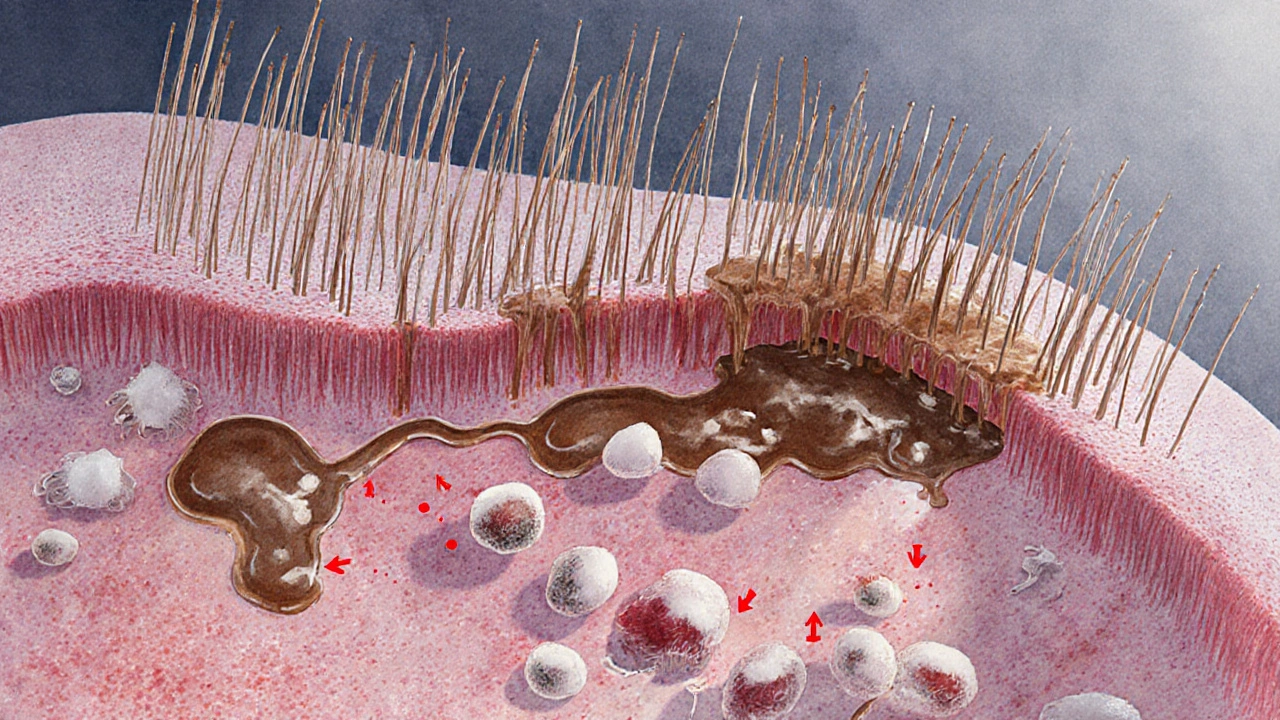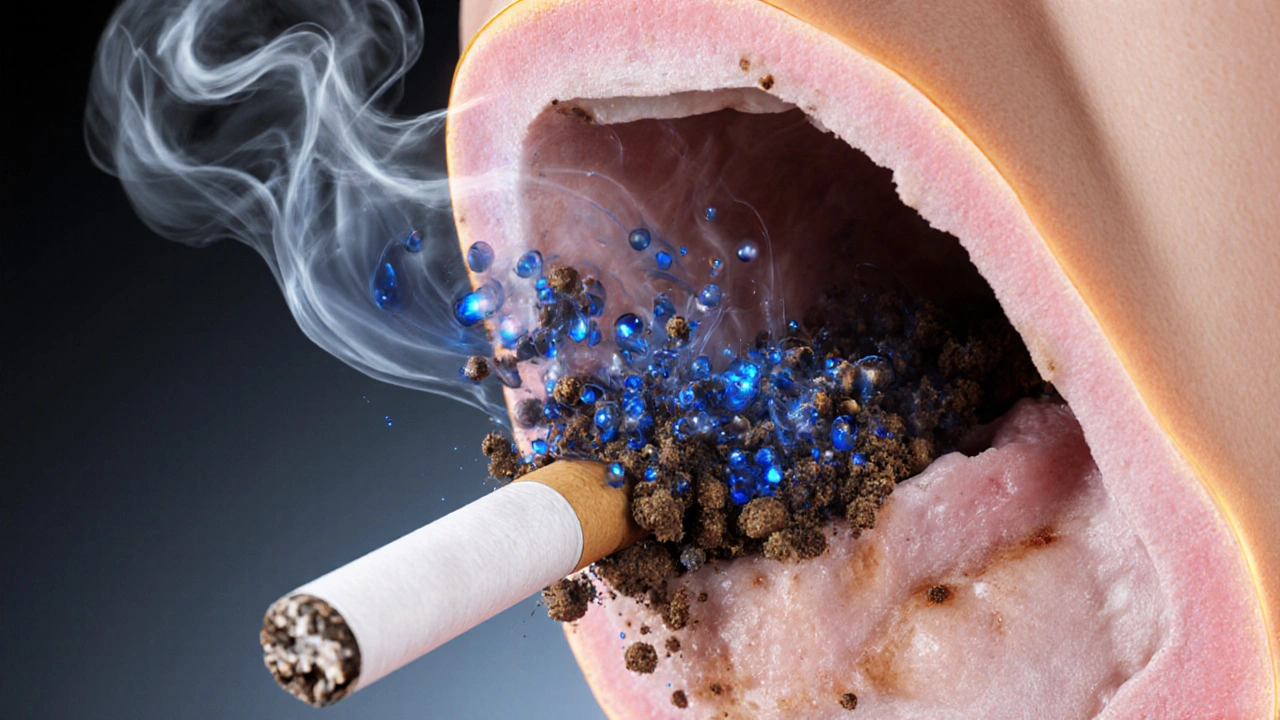Pharyngeal Health Impact Calculator
Enter your smoking details and click "Analyze Impact" to see health impacts and recovery estimates.
Key Findings
- Each cigarette exposes the pharyngeal mucosa to harmful substances including nicotine, tar, and carbon monoxide.
- Long-term smoking impairs ciliary function, increases inflammation, and raises cancer risk.
- Recovery begins within 24-48 hours of quitting and continues for months.
Key Takeaways
- Every puff delivers nicotine, tar, carbon monoxide and other toxins straight to the throat’s moist lining.
- Smoke irritates the pharyngeal mucous membranes, disables cilia, and sparks chronic inflammation.
- Long‑term exposure raises the odds of chronic pharyngitis, ulcers, and throat cancer.
- Quitting starts a healing process that can restore most of the damage within months.
- Simple daily habits-hydration, humidified air, and avoiding irritants-help the throat recover faster.
How Smoking Affects the Pharyngeal Mucous Membranes
When you light a cigarette, smoking the act of inhaling tobacco smoke that carries nicotine, tar, carbon monoxide, and many other chemicals forces those substances onto the pharyngeal mucous membranes the moist, protective lining of the throat and upper airway. The thin cellular layer is designed to stay wet, trap particles, and keep the airway clear. Smoke, however, dries the surface, introduces corrosive compounds, and overwhelms the natural defenses.
The immediate sensation is a scratchy throat, but the underlying damage starts at the microscopic level. Each inhalation deposits thousands of molecules that interact with cells, nerves, and immune factors in the throat. Over weeks, those tiny hits accumulate into visible problems-persistent soreness, hoarseness, and eventually pre‑cancerous lesions.
Main Harmful Components in Cigarette Smoke
Not all parts of tobacco smoke are equal. Here are the three culprits that matter most for the throat:
- Nicotine the addictive alkaloid that stimulates blood vessels and nerves - narrows blood flow to the mucosa, reducing oxygen delivery.
- Tar a sticky mixture of carcinogenic chemicals that coats tissue - adheres to the throat lining, creating a film that traps other toxins.
- Carbon monoxide a colorless gas that binds to hemoglobin, lowering blood oxygen levels - deprives cells of the oxygen needed for repair.
Together, these agents turn a normally resilient membrane into a fragile, inflamed surface.

Biological Mechanisms of Damage
Irritation and Chemical Burn
Tar’s oily residue acts like a mild acid on the mucosa. It strips away the protective mucus layer, exposing epithelial cells to direct chemical assault. This triggers a pain response that manifests as a sore throat after each cigarette.
Impaired Ciliary Function
Cilia tiny hair‑like structures that beat rhythmically to move mucus out of the airway are the throat’s cleaning crew. Smoke particles coat the cilia, causing them to become sluggish or even die. When ciliary motion slows, mucus builds up, creating a breeding ground for bacteria and viruses.
Chronic Inflammation
The immune system reacts to the foreign chemicals by sending inflammatory cells to the area. Cytokines like IL‑6 and TNF‑α rise, leading to swelling, redness, and increased mucus production. Persistent inflammation weakens the tissue’s barrier function, making it easier for infections to take hold.
Immune Suppression
Nicotine also dampens local immune responses. It reduces the activity of macrophages and neutrophils, the cells that normally gobble up pathogens. The net effect is a higher risk of throat infections, especially during cold and flu season.
Cellular Changes and Cancer Risk
Tar contains polycyclic aromatic hydrocarbons (PAHs) that bind to DNA, causing mutations. Over years, those mutations accumulate and can turn normal cells into dysplastic or malignant ones. The throat’s epithelial lining is especially vulnerable because it’s the first point of contact.
Short‑ and Long‑Term Clinical Consequences
Here’s what you might notice at different stages of exposure:
- Immediate (hours to days): Scratchy throat, mild cough, increased phlegm.
- Intermediate (weeks to months): Persistent hoarseness, chronic pharyngitis, frequent sore throats, visible redness.
- Long‑term (years): Recurrent infections, ulcerations, leukoedema (white patches), dysplasia, and a markedly higher chance of squamous cell carcinoma of the pharynx.
Epidemiological data from the British Thoracic Society show that smokers are up to three times more likely to develop chronic throat inflammation than non‑smokers, and the risk of throat cancer jumps by over 200% after 20 pack‑years.
Risk Reduction and Recovery After Quitting
Good news: the throat can bounce back once you stop exposing it to smoke. The timeline looks roughly like this:
- 24‑48hours: Carbon monoxide levels fall, oxygen transport improves.
- 1‑2weeks: Cilia start to regrow, mucus clearance improves.
- 1‑3months: Inflammation markers drop, the mucus layer thickens again.
- 6‑12months: Visible healing of epithelial cells; risk of infection drops back toward that of a never‑smoker.
- 1‑5years: Cancer risk halves compared to a continuing smoker, though it never fully returns to baseline.
To accelerate healing, stay hydrated, use a humidifier in dry environments, and consider throat‑friendly herbal teas (like slippery elm) that coat the mucosa with a soothing film.

Practical Checklist for Protecting Your Throat
- Drink at least 2liters of water daily to keep the mucous membrane moist.
- Avoid second‑hand smoke, vaping clouds, and strong scented chemicals.
- Use a saline gargle twice a day if you feel persistent irritation.
- Limit alcohol and spicy foods, which can further dry the throat.
- Schedule a routine ENT check‑up if you have a 10‑year smoking history.
Comparison: Smoking vs. Non‑Smoking Effects on the Pharyngeal Mucosa
| Aspect | Smokers | Non‑Smokers |
|---|---|---|
| Mucus Thickness | Reduced, often dry | Normal, well‑lubricated |
| Ciliary Activity | Impaired, slower clearance | Efficient, rapid clearance |
| Inflammation Markers (IL‑6, TNF‑α) | Elevated | Baseline |
| Infection Frequency | 2‑3× higher | Standard |
| Risk of Dysplasia/ Cancer | 200%+ increase after 20pack‑years | Low baseline risk |
Frequently Asked Questions
Can occasional smoking still damage the throat?
Yes. Even a few cigarettes a week expose the pharyngeal mucosa to tar and nicotine, enough to cause irritation and reduce ciliary function. The damage may be subtle, but it adds up over time.
How long does it take for the throat to feel normal after quitting?
Most people notice less scratchiness within a week, and significant improvement in mucus clearance after about two weeks. Full mucosal healing can take several months, depending on smoking history.
Is vaping any better for the pharyngeal membranes?
Vaping eliminates many combustion by‑products, but it still delivers nicotine, propylene glycol, and flavor chemicals that can dry and irritate the throat. It’s a lower‑risk option, not a risk‑free one.
Should I get screened for throat cancer if I’ve smoked for years?
If you have a 20‑pack‑year history or notice persistent hoarseness, a referral for laryngoscopic examination is advisable. Early detection dramatically improves outcomes.
Do throat lozenges help reverse damage?
Lozenges can soothe temporary irritation and add moisture, but they don’t repair cellular damage. They’re useful for comfort while you focus on quitting and staying hydrated.
Understanding how smoking assaults the pharyngeal mucous membranes gives you a concrete reason to protect that vital gateway to your lungs. Whether you’re planning to quit or just want to reduce harm, the steps above can keep your throat healthier and your voice clearer.


Andy Jones
October 8, 2025 AT 15:27The pharynx isn’t a disposable coffee filter, so inhaling tar repeatedly is basically sending a SWAT team of carcinogens straight to the tissue. It’s amazing how quickly those chemicals strip away the protective mucus layer and shut down the cilia, turning your throat into a junkyard of dead cells. And, of course, the inflammation that follows makes you sound like a gravelly radio host for weeks.
Kevin Huckaby
October 18, 2025 AT 01:03🚬💥Let’s be real, America’s love affair with cigarettes is a cultural tragedy-like a fireworks show that’s always set off inside your throat. You think you’re just getting a quick buzz, but you’re actually installing a permanent “no‑entry” sign for healthy cells. 🇺🇸🔥💀
Brandon McInnis
October 27, 2025 AT 10:39Imagine a tiny, delicate garden inside your throat, and then picture a wildfire sweeping through it-that’s basically what smoking does. The damage isn’t just a fleeting irritation; it’s a slow‑burn that can scar the whole landscape. Stay hydrated, cherish that garden, and give it a chance to bloom again.
Aaron Miller
November 5, 2025 AT 20:15One must acknowledge, with a certain gravitas, that the act of smoking constitutes an affront to the very integrity of the pharyngeal membrane; indeed, the influx of nicotine, tar, and carbon monoxide is nothing short of an aggressive siege, an indiscriminate bombardment-yet, some persist, perhaps out of misguided bravado; such persistence, however, merely accelerates the inexorable decline of mucosal resilience.
Roshin Ramakrishnan
November 15, 2025 AT 05:51It’s crucial to remember that quitting even a single cigarette can set off a cascade of healing processes; the body is remarkably resilient-stay patient, keep those fluids up, and consider gentle steam inhalation to soothe the lining; small, consistent steps will eventually outweigh the years of damage.
Todd Peeples
November 24, 2025 AT 15:27The mucosal epithelium of the pharynx serves as the first line of defense against inhaled xenobiotics. When tobacco combustion products deposit on this surface, they initiate a cascade of oxidative stress. Reactive oxygen species overwhelm the antioxidant capacity of the cells, leading to lipid peroxidation. Simultaneously, nicotine induces vasoconstriction, reducing perfusion and oxygen delivery. Tar, a complex mixture of polycyclic aromatic hydrocarbons, binds covalently to DNA bases, forming adducts. These adducts, if unrepaired, become mutagenic hotspots that can trigger oncogenic transformation. Moreover, carbon monoxide competes with oxygen for hemoglobin binding sites, exacerbating tissue hypoxia. The ciliary apparatus, crucial for mucus clearance, experiences functional impairment due to protein denaturation. Consequently, mucus stasis creates a nidus for bacterial colonization and persistent inflammation. Cytokine profiles shift toward a pro‑inflammatory phenotype, with elevated IL‑6, TNF‑α, and CRP levels. Chronic inflammation provokes fibroblast activation and extracellular matrix remodeling, contributing to fibrosis. Clinically, this manifests as chronic pharyngitis, hoarseness, and heightened susceptibility to upper respiratory infections. Epidemiological data correlate a pack‑year threshold of ten with a two‑fold increase in dysplasia incidence. Smoking cessation initiates a rapid decline in carbon monoxide levels within 24 hours, restoring normoxic conditions. Long‑term abstinence allows ciliary regeneration and gradual reversal of inflammatory markers, underscoring the plasticity of the airway epithelium. 😊👍
Chris Smith
December 4, 2025 AT 01:03Wow another post about smoking-like we needed more science. Sure, the throat gets messed up, but you already know that.